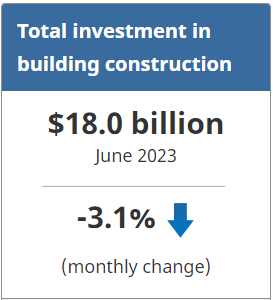Statistics Canada: Investment in Building Construction, June 2023
Investment in residential construction declined for the fourth straight month, falling 4.5% to $12.1 billion in June. Investment in non-residential construction edged down 0.2% to $5.9 billion. Overall, investment in building construction fell 3.1% to $18.0 billion in June.

After adjusting for inflation (2012=100), investment in building construction decreased 3.4% to $10.3 billion.
Residential sector continues to fall
Residential construction declined for the fourth consecutive month, falling 4.5% to $12.1 billion in June. Ontario (-5.8% to $5.1 billion) accounted for most of the drop.
Single family home construction fell 5.7% to $6.2 billion in June, with declines seen in eight provinces.
Multi-unit construction declined for the eighth straight month, falling 3.1% to $5.9 billion in June, the lowest level since September 2021.
Investment in non-residential sector edges down
Investment in non-residential construction edged down 0.2% to $5.9 billion in June due to widespread declines in Quebec (-3.1% to $1.3 billion).
Commercial construction was up 0.8% to $3.3 billion in June, while industrial (-1.4% to $1.2 billion) and institutional (-1.4% to $1.4 billion) construction both declined.
Second quarter of 2023 declines due to residential sector
Overall investment in building construction declined 5.2% to $55.7 billion in the second quarter, entirely due to a drop in residential construction (-8.2% to $37.9 billion). Non-residential construction was up 1.8% to $17.8 billion.
Investment in single family homes fell 10.5% to $19.7 billion in the second quarter, the largest decline since the second quarter of 2020. Multi-unit construction declined for the third straight quarter, falling 5.7% to $18.2 billion in the second quarter of 2023.
Investment in non-residential construction rose 1.8% to $17.8 billion in the second quarter, the 10th consecutive quarterly increase. Investment in industrial buildings rose 5.6% to $3.7 billion, while commercial construction increased 1.7% to $9.8 billion.
Institutional construction decreased 0.9% to $4.4 billion, with Quebec (-4.6% to $1.3 billion) accounting for most of the decline.
For more information on construction, please visit the Construction statistics portal.
For more information on housing, please visit the Housing statistics portal.
Note to readers
Data are subject to revisions based on late responses, methodological changes and classification updates. Unadjusted data have been revised from January 2019 and seasonally adjusted data have been revised from January 2016.
Data presented in this release are seasonally adjusted with current dollar values unless otherwise stated. Using seasonally adjusted data allows month-to-month and quarter-to-quarter comparisons by removing the effects of seasonal variations. For information on seasonal adjustment, see Seasonally adjusted data – Frequently asked questions.
Monthly estimates in constant dollars are calculated using quarterly deflators from the Building Construction Price Index (table 18-10-0135-01). Typically, the first two months of a quarter use the previous quarter’s price level, and the data are revised when the new quarterly price index becomes available.
Detailed data on investment activity by type of building and type of work are now available in the unadjusted current dollar series.
The trade and services subcomponent includes buildings such as retail and wholesale outlets, retail complexes, and motor vehicle show rooms. More detailed information can be found on the Integrated Metadatabase at Types of Building Structure – 2.2.1 – Trade and services.
Next release
Data on investment in building construction for July will be released on September 18.
Products
Statistics Canada has a “Housing Market Indicators” dashboard. This web application provides access to key housing market indicators for Canada, by province and census metropolitan area. These indicators are automatically updated with new information from monthly releases, giving users access to the latest data.
Source: Statistics Canada

